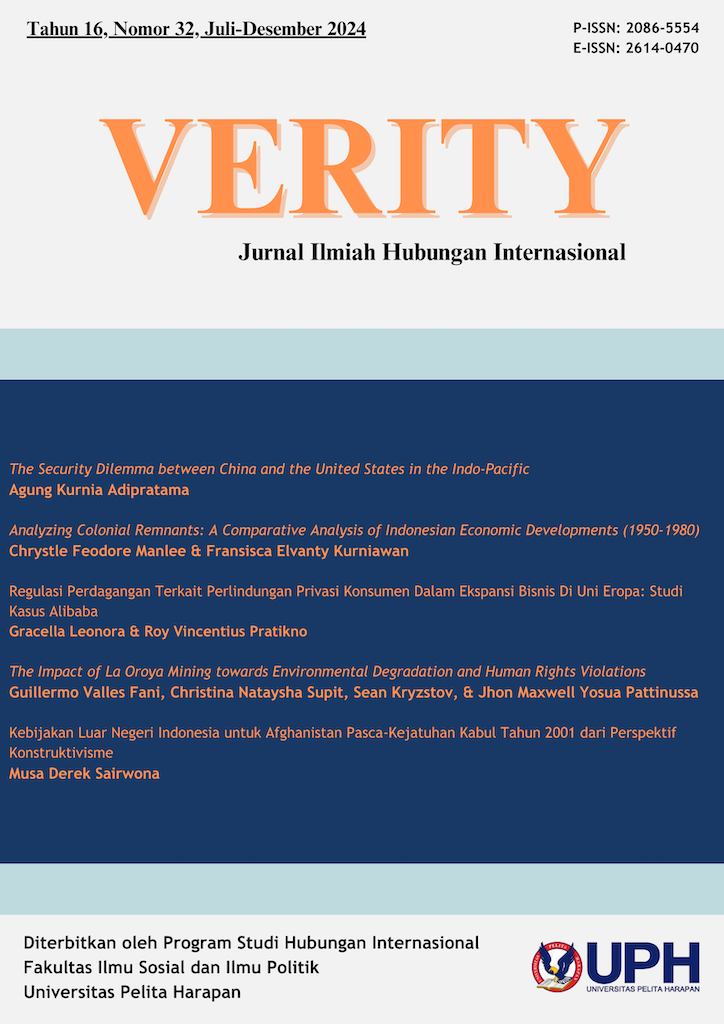THE SECURITY DILEMMA BETWEEN CHINA AND THE UNITED STATES IN THE INDO-PACIFIC
DOI:
https://doi.org/10.19166/verity.v16i32.9098Keywords:
China, United States, Security Dilemma, Indo-Pacific, Dilema Keamanan, Tiongkok, Amerika Serikat, Indo-PasifikAbstract
China’s tremendous economic growth from 1978 to 2010s has enabled Beijing to expand military growth for Beijing. This has made China to become more prosperous and stronger than ever before. This is also shifting the balance of power in the Indo-Pacific region, especially when the United States is already being the dominant power since the end of Cold War. Throughout different years the United States has had different perceptions on commenting China’s rise. Since 2020 relations between two countries have been intensified when then Chinese Foreign Minister Wang Yi mentioned the resurfacing of “Cold War” mentality. This essay employed examples from case studies and interactions between leaders and social actors. This essay is going to discuss extensively on the rise of China and the reactions from the United States towards that. Furthermore, it is going to explain how a security dilemma between the two countries occurred that stemmed from the two factors aforementioned. This writing discovered that the rise of China that completely shifted the balance of power is through military presence in South China Sea. China has employed military, diplomatic and economic powers to influence the reality on the ground. This is a reality that United States had to willingly accepted and trying to alter course of balance of power have been the norm for Washington. Lastly, this writing concludes that security dilemma occurred for both countries since the two are suspicious to one another.References
Archives, K. C. (1974). Dispute over Paracel and Spratly Islands. - Naval Clash off Paracels.
Chinese Occupation of Parcel Archipelago. Keeping’s Record of World Events, 20.
Benvenuti, A., Chung, C.-P., Khoo, N., & Tan, A. T. (2022). Historical drivers of China’s foreign policy. China’s Foreign Policy, 32–47. doi: 10.4324/9781003088288-4.
Berg, B. L. (2001). Qualitative Research Methods for The Social Sciences. Needham Heights,
MA: Allyn & Bacon.
Creswell, J. (2003). Research design - qualitative, quantitative, and mixed method
approaches John W. Creswell. Thousand Oaks, CA: Sage Publications.
Ding, A. S., & Panda, J. P. (2021). Chinese Politics and Foreign Policy under Xi Jinping.
Oxford: Routledge Studies on Think Asia.
Folly, M. H. (2000). Cold War history. Houndmills, Basingstoke, Hampshire: Macmillan
Press.
Guan, A. C. (1999). The South China Sea Dispute Re-visited. Institute Defence and Strategic
Studies.
Imannurdin, Y., Sudiarso, A., & Sianturi , D. (2024). The Impact of The AUKUS Alliance on
China’s Influence in The Indo-Pacific Region. International Journal of Humanities
Education and Social Sciences, 3(5). doi: https://doi.org/10.55227/ijhess.v3i5.976.
Mastanduno, M. (2023). Realist Theories and US Foreign Policy in the Indo-Pacific. The
Routledge Handbook of US Foreign Policy in the Indo-Pacific.
Masuda, M., & Mattelaer, A. (2024). The Long Shadow? China’s Military Rise in the Indo-
Pacific and its Global Implications. Centre for Security, Diplomacy and Strategy
Policy Brief, 18.
McLaughlin, M. (2020). U.S. Strategy in the South China Sea. American Security Project.
Mearsheimer, J. J. (2014). The Tragedy of Great Power Politics. New York, NY: W.W.
Norton & Company.
Myers, L. (2023). China’s Economic Security Challenge: Difficulties Overcoming the
Malacca Dilemma. Georgetown Journal of International Affairs.
Parker, J. (2023). Not Just Another Naval Exercise: Malabar’s Vital Messaging. Australian
Strategic Policy Institute.
Rim, H. J., & Platte, J. E. (2023). Indo-Pacific Strategies and Foreign Policy Challenges:
The US-china strategic competition. London: Routledge, Taylor & Francis Group.
Ross, R. S. (2012). The Problem with the Pivot: Obama’s New Asia Policy is Unnecessary
and Counterproductive. Council on Foreign Relations, 91(6), 70–82.
Ross, R. S. (2013). US Grand Strategy, the Rise of China, and US National Security Strategy
for East Asia. Strategic Studies Quaterly, 7(2).
Scott, D. (2018). The Indo-Pacific in US Strategy: Responding to Power Shifts. NATO
Defense College, 3(2), 19–43.
Scott, D. (2019). China’s Indo-Pacific Strategy: The Problems of Success. Journal of
Territorial and Maritime Studies, 6(2), 94–113.
Smith, S. A. (2021). The Quad in the Indo-Pacific: What to Know. Council on Foreign
Relations.
State, U. S. D. of. (2017). President Trump releases National Security Strategy - United
States Department of State. Retrieved from https://2017-2021.state.gov/presidenttrump-
releases-national-security-strategy/.
United States, G. of. (2022). Indo-Pacific strategy. Retrieved from
https://www.whitehouse.gov/wp-content/uploads/2022/02/U.S.-Indo-Pacific-
Strategy.pdf.
Walt, S. (2023). Does anyone still understand the “security dilemma”? Retrieved from
https://foreignpolicy.com/2022/07/26/misperception-security-dilemma-ir-theoryrussia-
ukraine/.
Walters, R. (2023). China’s Military Puts Indo-Pacific on Edge. GIS Report Online.
Whiting, A. (2018). China’s role in the Vietnam War. The American War in Vietnam, 71–76.
doi: 10.7591/9781501719462-005.
Zoellick, R. B. (2001). National Committee on U.S.-China Relations. In U.S. Department of
State Archive (pp. 0–10). New York: U.S. Department of State Archive.
Downloads
Published
Issue
Section
License
Copyright (c) 2024 Agung Kurnia Adipratama

This work is licensed under a Creative Commons Attribution-ShareAlike 4.0 International License.
Authors who publish with this journal agree to the following terms:
1) Authors retain copyright and grant the journal right of first publication with the work simultaneously licensed under a Creative Commons Attribution License (CC-BY-SA 4.0) that allows others to share the work with an acknowledgement of the work's authorship and initial publication in this journal.
2) Authors are able to enter into separate, additional contractual arrangements for the non-exclusive distribution of the journal's published version of the work (e.g., post it to an institutional repository or publish it in a book), with an acknowledgement of its initial publication in this journal.
3) Authors are permitted and encouraged to post their work online (e.g., in institutional repositories or on their website). The final published PDF should be used and bibliographic details that credit the publication in this journal should be included.


